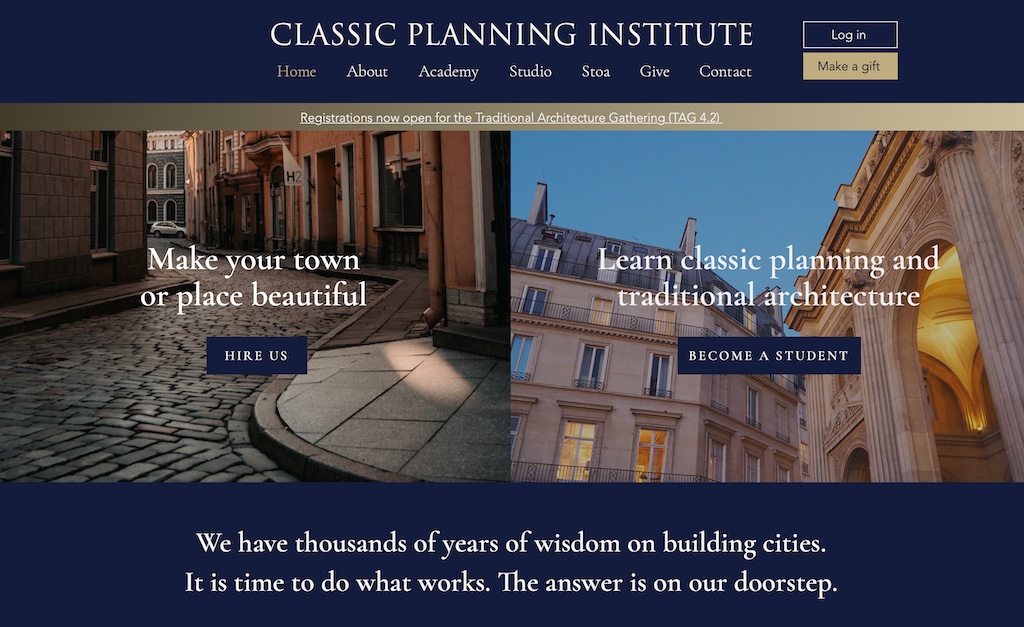We can demand beauty in architecture
You likely have a gut feeling about what ’feels right’ and good when you walk down the street. This feeling is backed up by science. Research demonstrates that we are healthier and happier in compact towns and cities with traditional architecture and planning — in fact, exquisite architecture and successful urbanism measurably reduce stress and increase human wellbeing.
Classic Planning Institute
Proponents
Proponents of beauty in cities include:
- Classic Planning Institute
- The Aesthetic City
- Create Streets
- Sir Roger Scruton, e.g. in this video Why Beauty Matters
- Street Level Australia, e.g. in this article Beautiful cities are a human right

Beauty can be measured
This paper calls for unambiguously using the “beautiful” in terms of neuroaesthetic biological responses rather than through aesthetic preference or art-historical terms. Its purpose is to help reclaim the appropriate and practical design toolkits that past generations possessed. In order to do so, the research gap that this paper is addressing is in the relation between aesthetic experience, the fractal characteristics of built form, and the neural sequencing of that processing in real time. Assisted by the latest scientific understanding of perception, it is indeed possible to once again create legacies of beautiful places for the greatest well-being of the greatest number of people.
Brielmann et al (2022) What Happens in Your Brain When You Walk Down the Street?

A new development and planning framework
The report of the Building Better Building Beautiful Commission from the UK proposes a new development and planning framework, which will:
- Ask for Beauty
- Refuse Ugliness
- Promote Stewardship
We do not see beauty as a cost, to be negotiated away once planning permission has been obtained. It is the benchmark that all new developments should meet. It includes everything that promotes a healthy and happy life, everything that makes a collection of buildings into a place, everything that turns anywhere into somewhere, and nowhere into home. So understood beauty should be an essential condition for the grant of planning permission.
Ask for Beauty
People do not only want beauty in their surroundings. They are repelled by ugliness, which is a social cost that everyone is forced to bear. Ugliness means buildings that are unadaptable, unhealthy and unsightly, and which violate the context in which they are placed. Such buildings destroy the sense of place, undermine the spirit of community, and ensure that we are not at home in our world.
Refuse Ugliness
Our built environment and our natural environment belong together. Both should be protected and enhanced for the long-term benefit of the communities that depend on them. Settlements should be renewed, regenerated and cared for, and we should end the scandal of left-behind places, where derelict buildings and vandalised public spaces drive people away. New developments should be regenerative, enhancing their environment and adding to the health, sustainability and biodiversity of their context. For too long now we have been exploiting and spoiling our country. The time has come to enhance and care for it instead. Our recommendations are designed to ensure that we pass on to future generations an inheritance at least as good as the one we have received.
Promote Stewardship


Examples of beauty in the City of Yarra


How to promote beauty and refuse ugliness in Yarra
Council can help to promote beauty and refuse ugliness in Yarra via two paths of reform:
- street votes, and
- 100 year plans.
Street Votes are a method proposed by Policy Exchange in their Strong Suburbs report, giving local people the power to set their own local development rules in suburban areas. The proposal is supported by the UK government.

100 year plans are a process described in The Art of Classic Planning, by Nir Haim Buras, which “guides placement of infrastructure and transportation, reconnects neighbourhoods, plans for sea level rise and waterfront development, and attracts investment and economic development in alignment with urban beauty, civic pride, and sustainability.”

